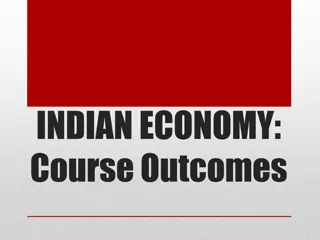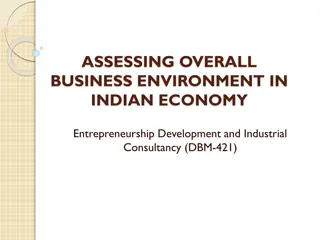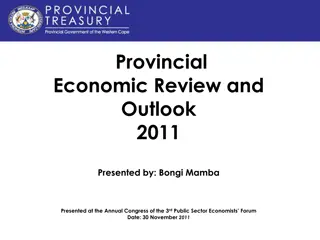
Impact of Coronavirus on Indian Economy: Challenges & Outlook
Coronavirus outbreak in China is significantly impacting the Indian economy, leading to disruptions in various sectors, including imports, exports, and industries located in China. The dependency on China for imports and the presence of Indian companies in affected regions are key factors affecting the economy. Immediate policy actions and fiscal stimulus are crucial for managing the economic impact.
Download Presentation

Please find below an Image/Link to download the presentation.
The content on the website is provided AS IS for your information and personal use only. It may not be sold, licensed, or shared on other websites without obtaining consent from the author. If you encounter any issues during the download, it is possible that the publisher has removed the file from their server.
You are allowed to download the files provided on this website for personal or commercial use, subject to the condition that they are used lawfully. All files are the property of their respective owners.
The content on the website is provided AS IS for your information and personal use only. It may not be sold, licensed, or shared on other websites without obtaining consent from the author.
E N D
Presentation Transcript
Coronavirus (CoV) is a large family of viruses that causes illness. It ranges from the common cold to more severe diseases like Middle East Respiratory Syndrome (MERS-CoV) and Severe Acute Respiratory Syndrome (SARS-CoV). The novel coronavirus is a new strain of virus that has not been identified in humanso far. WHO is working closely with global experts, governments, and other health organisations to provide advice to the countries about precautionary and preventive measures. We can t ignore the fact that the outbreak of COVID-19 in China is expected to have a significant impact on the economy globally including economic slowdown, trade, supply chain disruption, commodities, and logistics. The rapid outbreak of deadly Coronavirus pandemic in the country has not only led to a panic-like situation amongst the citizens, but has also hit Indian economy - which was already reeling under a significant slowdown over the past few quarters. The medical rampant has presented fresh set of challenges for the country's economy, causing severe disruptive impact on investment andconsumption demand. Country's economy, which was growing at a six-year low rate of 4.7 per cent in the third quarter of the current fiscal, had strong hopes of recovery in the fourth quarter. However, the new Coronavirus epidemic has made the recovery extremely difficult in the near to mediumterm. According to a survey conducted by industry body FICCI, the outbreak has assembled new roadblocks for the Indian economy now, causing severe disruptive impact on both demand and supply side elements whichhas the potential to derail India s growth story.
Up to a large extent, it will impact the Indian industry. In imports, the dependence of India on China is huge. Of the top 20 products (at the two-digit of HS Code) that India imports from the world, China accounts for a significant share in most of them. India s total electronic imports account for 45% of China. Around one-third of machinery and almost two-fifths of organic chemicals that India purchases from the world come from China? For automotive parts and fertilisers China s share in India s import is more than 25%. Around 65 to 70% of active pharmaceutical ingredients and around 90% of certain mobile phones come from China to India. Therefore, we can say that due to the current outbreak of coronavirus in China, the import dependence on China will have a significant impact on the Indian industry. In terms of export, China is India s 3rdlargest export partner and accounts for around 5% share. The impact may result in the following sectors namely organic chemicals, plastics, fish products, cotton, ores, etc. We also can t ignore that most of the Indian companies are located in the eastern part of China. In China, about 72% of companies in India are located in cities like Shanghai, Beijing, provinces of Guangdong, Jiangsu, and Shandong. In various sectors, these companies work including Industrial manufacturing, manufacturing services, IT and BPO, Logistics, Chemicals, Airlines, and tourism. It has been seen that some sectors of India have been impacted by the outbreak of coronavirus in China including shipping, pharmaceuticals, automobiles, mobiles, electronics, textiles, etc. Also, a supply chain may affect some disruptions associates with industries and markets. Overall, the impact of coronavirus in the industry is moderate. According to CLSA report, pharma, chemicals, and electronics businesses may face supply-chain issues and prices will go up by 10 percent. The report also says that India could also be a beneficiary of positive flows since it appears to be the least-impacted market. Some commodities like metals, upstream and downstream oil companies, could witness the impact of lower global demand impacting commodity prices. According to CII, GDP could fall below 5% in FY 2021 if policy action is not taken urgently. It is said that the government should take some strong fiscal stimulus to the extent of 1% of GDP to the poor, which would help them financially and also manage consumer demand In the third quarter (October-December) growth is slowed down to 4.7% and the impact of COVID-19 will further be seen in the fourth quarter. FICCI survey showed 53% of Indian businesses have indicated a marked impact of COVID-19 on business operations. And 42% of the respondents said that up to three months could take for normalcy to return.
As per FICCI survey, tourism, hospitality and aviation are among the worst affected sectors that are facing present Coronavirus pandemic. Closing of cinema theaters and declining footfall in shopping complexes have affected the retail sector by impacting consumption of both essential the maximum brunt of the and discretionary items. Consumption is also getting impacted due to job losses and decline in income levels of people, particularly the daily wage earners due to slowing activity in several sectors including retail, construction, entertainment and others, the survey stated. With widespread fear and panic rapidly increasing among people across the country, overall confidence level of consumers has dropped significantly, leading to postponement of their purchasing decisions. Even the travel restrictions imposed by Central government to prevent the spread of Covid- 19 in India have severely impacted the transport sector.
Large scale shutdown of factories and resulting delay in supply of goods from China have affected many Indian manufacturing sectors. According to the FICCI report, sectors like automobiles, pharmaceuticals, electronics, chemical products etc. are facing an imminent raw material and component shortage. Besides having a negative impact on imports of important raw materials, the slowdown in manufacturing activity in China and other markets of Asia, Europe and the US is impacting India s exports to these countries as well, the report added.
Greater uncertainty about the future course and repercussion of Covid-19 has also made the financial market extremely volatile, leading to huge crashes and wealth erosion, which in turn is impacting consumption levels, FICCI report said. One of the massive crashes of domestic equity market was seen on March 12, when following the trend of the global equity markets, both the BSE Sensex and NSE Nifty crashed by more than 8 per cent in a single day. An estimated Rs 10 lakh crore of market cap was reportedly wiped off due to this single day fall. The fall has continued till date as investors resorted to relentless selling amid rising cases of Coronavirus. With equity markets likely to remain volatile in future as well, further wealth erosion of investors is expected.
The Coronavirus pandemic has also pulled down India's economic growth projections. Given the challenges that the businesses and people are facing currently, the Indian economy is most likely to experience a lower growth during the last quarter of the current fiscal, the report claimed. It is also being said that in case the spread of Coronavirus continues, India's growth may remain subdued in the first quarter of FY 20-21 as well. Rating agency Moody's Investors Service has revised down its growth forecast for India to 5.3 per cent for 2020 from its earlier estimate of 5.4 per cent made in February. According to the Health Ministry data, the COVID-19 cases in India rose to 195 on Friday after 22 fresh cases were reported from various parts of the country.
The way new cases are cropping up every day, it doesnt appear that the lockdown would be completely lifted after the three week period. And if that continues, even partially, the third and the potentially biggest impact would be felt on the data collection across the country. Data on inflation, especially food, which consists a large part of India s inflation basket employment, production and consumption is a vital input in policy-making and to the central bank, which sets interest rates and forecasts the future trajectory of growth and price movement. Inflation data is collected from close to 1,200 village markets and 1,115 urban centres. The lockdown implies virtually no data collection as these centres of trade are not so developed for the compilation of numbers on the phone or the internet. In the absence of data, the next RBI monetary policy in June may be reduced to only a stock-taking exercise of the current crisis. The cumulative impact of all that on the GDP growth would be huge and India will be nowhere close to touching the estimated 5% in 2019-20. Various estimates suggest growth could even plummet to 2.5-3% in 2020-21. Worse, the country could see a quarterly contraction in the April-June quarter of 2020-21. Growth is not expected to top 2.5% even in 2020-21. But the good part is, India s economy is still forecast to be better than many other countries of the world, which has entered a recession as bad or even worse than the global financial crisis of 2008, according to the International Monetary Fund (IMF). But it is very challenging to assess the full impact of the virus until the spread is not contained. The pandemic has caused demand and supply shocks. The RBI has refrained from giving growth and inflation forecast amidst unprecedented uncertainty. It reckoned that the growth number and inflation print would be heavily contingent on the intensity, spread and duration of the virus.
Chemical Industry: Some chemical plants have been shut down in China. So there will be restrictions on shipments/logistics. It was found that 20% of the production has been impacted due to the disruption in raw material supply. China is a major supplier of Indigo that is required for denim. Business in India is likely to get affected so people securing their supplies. However, it is an opportunity. US and EU will try and diversify their markets. Some of the business can be diverted to India which can also be taken as an advantage. Shipping Industry: Coronavirus outbreak has impacted the business of cargo movement service providers. As per the sources, per day per vessel has declined by more than 75-80% in dry bulk trade. Auto Industry: Its impact on Indian companies will vary and depend upon the extent of the business with China. China s business no doubt is affected. However, current levels of the inventory seem to be sufficient for the Indian industry. If the shutdown in China continues then it is expected to result in an 8-10% contraction of Indian auto manufacturing in 2020. Pharmaceuticals Industry: Despite being one of the top formulations of drug exporters in the world, the pharma industry of India relies heavily on import as of bulk drugs. Due to the coronavirus outbreak, it will also be impacted.
Textiles Industry: Due to coronavirus outbreak, several garments/textile factories in China have halted operations that in turn affecting the exports of fabric, yarn and other raw materials from India. Solar Power Sector: I Indian developers may face some shortfall of raw materials needed in solar panels/cells and limited stocks from China. Electronics Industry: The major supplier is China in electronics being a final product or raw material used in the electronic industry. India s electronic industry may face supply disruptions, production, reduction impact on product prices due to heavy dependence on electronics component supply directly or indirectly and local manufacturing. IT Industry: The New Year holidays in China has been extended due to coronavirus outbreak that adversely impacted the revenue and growth of Indian IT companies. Tourism and Aviation: Due to the coronavirus outbreak, the inflow of tourists from China and from other East Asian regions to India will lose that will impact the tourism sector and revenue.
To mitigate the impact, it gave a deep policy interest rate cut of 75 basis points and brought it down to 4.4%, the lowest in the history of independent India. It brought down the cash reserve ratio (CRR) to 3% from 4%, for the first time in seven years and introduced long term repo operations (LTRO) to improve transmission and supply of durable liquidity. This was a part of coordinated policy decisions that other countries too have taken to lessen the impact of the epidemic. Around 45 countries around the world have cut key policy rates. Some of them like Australia, US, UK and Canada have reduced policy rates twice in the span of 7-15 days this month. The RBI took certain other measures too for a far-reaching impact on the economy. A reduction in repo rate will not only make loans cheaper for individuals and companies but will also give a boost to growth as seen during the global financial crisis when as a result of repo reduction, the quarterly GDP had seen an upswing. A CRR cut will help infuse Rs 1.37 lakh crore into banking system and reduce cost of funds for banks. At present credit demand in the system is low but banks have to provide interest on deposits held by them. Hence, the cut in CRR is expected to help banks to bridge their temporary asset-liability mismatch. Besides, it allowed a blanket forbearance for all term loans and working capitals, providing succour not only to those, who have taken personal loans but also businesses, who have taken working capital. This will help firms, which have almost nil revenue earning, to pay for their utilities and staff in the lockdown.
The fiscal package of Rs 1.70 lakh crore is not enough for Indias vast majority of the poor. The crisis is deep for self-employed and migrant labourers. The migrant workforce neither has a bank account at the place of their work, nor a ration card facility to take the benefit of free grains. The government may come up with dated food coupons for such workers, which can be used until the normal business activities are restored. An estimated cost involved in the stimulus could be anywhere between Rs 8 lakh crore and Rs 10 lakh crore. On the revenue side, the benefits of lower crude prices could result in accrual of Rs 2.5 lakh crore to the exchequer in the financial year 2020-21. The rest could come through more extensive and tough reform measures, which may open the doors for new taxes and cess in the coming times. But the concern at the moment is humanitarian and calculating the cost to the economy at a time when a human tragedy has struck the globe would be cruel. The government too is acting, without worrying much for fiscal deficit. The Fiscal Responsibility and Budget Management Act allows RBI to help centre in all possible ways, including printing of more currency notes, in case it breaches the fiscal target on account of a national calamity, an act of war, collapse of agriculture severely impacting farm output and incomes among others. But the current epidemic has reinforced the need for the central banks, the world over, to maintain robust balance sheets and the governments, not to appropriate their savings. The economic recovery is expected to be slow and uneven after the health crisis is over, as most of the informal sector will not be able to re-start their businesses, the unemployment rate could hit its peak and experts suggest that the lockdown could bring in behavioural change in people, including their consumption and savings. According to India s first chief statistician and currently the government s data quality manager, Pronab Sen, when the business activity is resumed after the crisis, the recovery could be V-shaped initially but after a short spike, the momentum will decrease and the long-term impact of the crisis will start resurfacing.






















